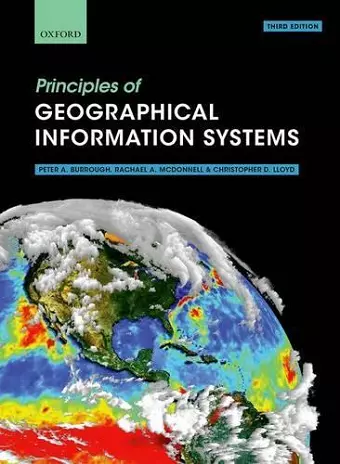Principles of Geographical Information Systems
Christopher D Lloyd author Professor Peter A Burrough author Rachael A McDonnell author
Format:Paperback
Publisher:Oxford University Press
Published:23rd Apr '15
Should be back in stock very soon

Geographical data are used in so many aspects of our lives today, ranging from disaster relief operations through to finding directions on our mobile phones. We can all be data collectors, adding locational information as we capture digitally our day-to-day experiences. Geographical Information Systems (GIS) are the software tools that facilitate this, turning the raw data into useful information that can help us understand our worlds better. Principles of Geographical Information Systems presents a thorough overview of the subject, exploring both the theoretical basis of GIS, and their use in practice. It explains how data on the world are converted into digital form and the analytical capabilities used to bring understanding to a range of areas of interest and issues. Spatial data are usually based on two, dichotomous paradigms: exactly defined entities in space, such as land parcels and urban structures, or the continuous variation of single attributes, such as temperature or rainfall. The adoption of one or the other influences how the geographical data are structured in the GIS and the types of analysis possible. A further area of focus in the book concerns the problems of data quality and how statistical errors in spatial data can affect the results of spatial modelling based on the two paradigms of space. Fuzzy logic and continuous classification methods are presented as methods for linking the two spatial paradigms. The book concludes with an overview of current developments and trends in providing spatial data to an ever-expanding global community of users.
Review from previous edition [This second edition] builds upon the previous work in providing a very welcome basic, concise and more up to date introduction to the principles underlying GISs ... a osund and readable introduction to a complex subject. * International Research in Geographical and Environmental Education, v. 9 no. 3, 2000 *
Choosing a course text in the early post-GIS years was very easy. Peter Burrough's Principles of geographical Information Systems for Land Resources Assessment was the definitive work. Beautifully written and illustrated...Peter Burrough set himself a hard act to follow...In almost every respect this is a new book, and not the second edition it purports to be...So, this is a rarity in textbook publishing a second edition that improves on the first. It looks set to be my recommended course text for many years to come. * David Unwin/GIS Europe June 1998. *
This book presents a strong theoritical basis for GIS, which is often lacking in other texts...the optimising of timber extraction from forests and the redistribution of Chernobyl radioactivity by floods are explained clearly in detail. * Mapping Awareness April 1998 *
This new publication is up to date and provides comprehensive coverage of virtually all aspects of GIS. It is clearly written and technical where appropriate ... it should be recommended for postgraduate courses and for all teachers of GIS. * David Walker, The Times Higher Education Supplement *
ISBN: 9780198742845
Dimensions: 265mm x 199mm x 14mm
Weight: 748g
352 pages
3rd Revised edition